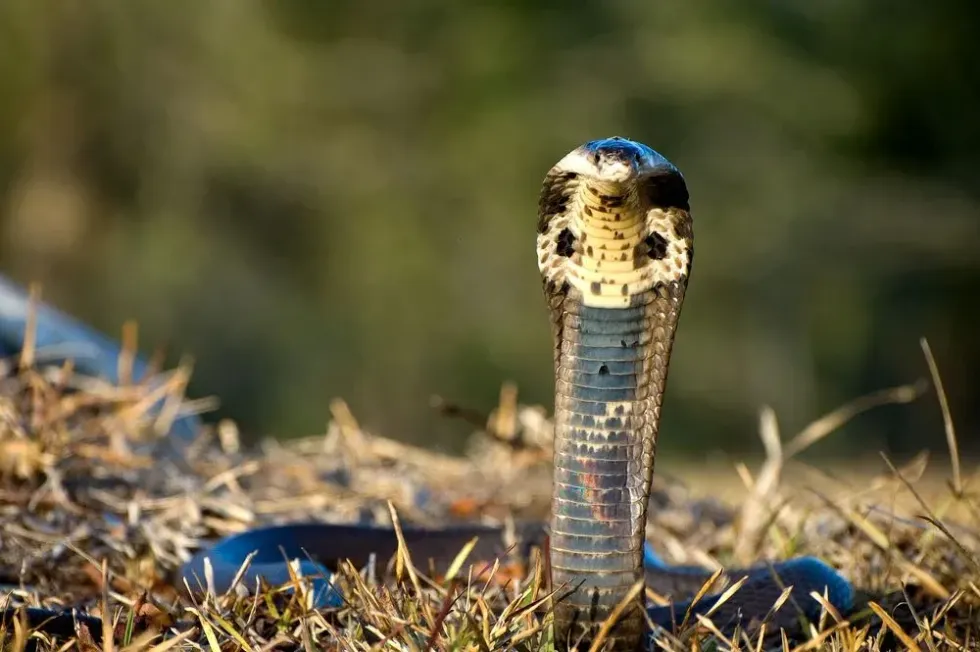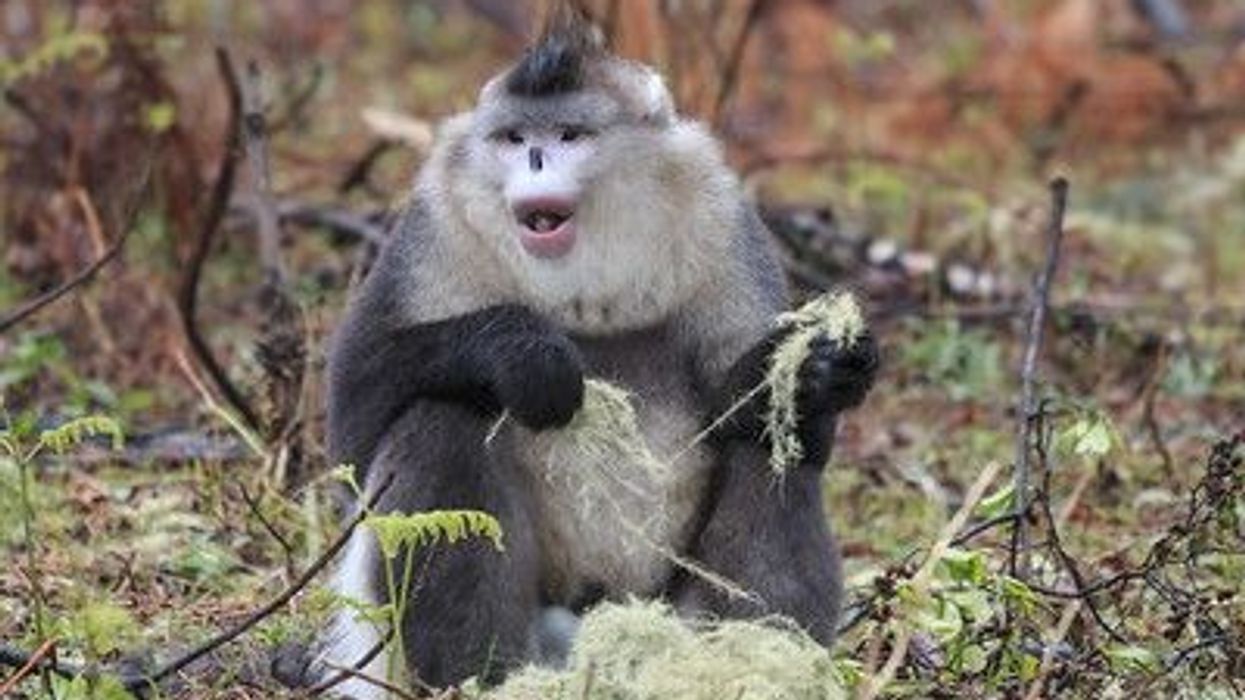The monocled cobra (Naja kaouthia) is a beautiful but deadly snake found in India, Bangladesh, Bhutan, Myanmar, Laos, Nepal, and Thailand. They are in the class Reptilia, order Squamata, suborder Serpentes, family Elapidae.
The Naja kaouthia, monocled cobra, is known for its unique monocellate or O-shaped hood pattern, and for its venom which can be deadly. It is semi-aquatic and is mostly found in habitats associated with water.
To read more about this fascinating snake, take a look at this article! If you are interested in other dangerous or venomous snakes, read our articles about the western diamondback rattlesnake and the black mamba.
Monocled Cobra Interesting Facts
What type of animal is a monocled cobra?
The monocled cobra is a species of snake. It is in the genus Naja, which is a group of venomous snakes.
What class of animal does a monocled cobra belong to?
The monocled cobra is a reptile.
How many monocled cobras are there in the world?
There are no official estimates of how many monocled cobras there are in the world. However, they are common in their habitat.
Where does a monocled cobra live?
The monocled cobra originates from South Asia and Southeast Asia. It can be found from West India to China, Vietnam, and Cambodia.
It can also be found in the Malay Peninsula. It is also native to India, Bangladesh, Bhutan, Myanmar, Laos, Nepal, and Thailand. You can find these snakes mostly in wetland areas, but they can also be found in areas of vegetation.
What is a monocled cobra's habitat?
These snakes can adapt to a variety of habitats. They prefer habitats associated that are moist, wet, and watery such as swamps, mangroves, and paddy fields. If outside of wetter areas, they can be found in grasslands.
Drier habitats include grasslands, shrublands, agricultural land, and forests. They are often found in tree holes and areas perfect for nesting or napping. They may also be found above land in areas up to 3300 ft (1006 m) above sea level and even in human settlements such as cities.
Who do monocled cobras live with?
These snakes are solitary creatures and mostly live alone. They like to live in areas where rats and mice are plentiful for a tasty treat. If they are disturbed, they tend to flee.
How long does a monocled cobra live?
The average lifespan of these snakes is a range of 13-20 years.
How do they reproduce?
The monocled cobra (Naja kaouthia) reproduces just like other snakes. A male snake wraps around the female snake and they reproduce sexually. Sometimes this happens for several hours or even with a group of snakes. The reproduction period for these snakes is between January and March.
Monocled cobras lay eggs. Normally they lay 16-33 eggs per clutch (batch of eggs). The eggs are then incubated in a nest for a range of 55-73 days. The female snake stays with the eggs until they hatch.
What is their conservation status?
This snake has a conservation status Least Concern. This means that they are not at risk of becoming extinct and they also do not have any major threats. In the future, however, habitat loss could become one of their major threats.
Monocled Cobra Fun Facts
What do monocled cobras look like?
This snake has a hood that has an O-shaped pattern on the rear end that looks like the old-fashioned monocle eyewear. This pattern makes them easy to spot.
Young monocled cobras are yellow, gray, brown, or black. Adult monocled cobras are olive, brown, or black and can have a yellow or orange O-shaped mark on the hood. They also have two black spots on the inside of the hood.
They have two circular ocelli connected by a curved line. Ocelli is a pair of simple eyes.
They also have elongated nuchal ribs which expand. As snakes get older, they actually get paler. They also have a pair of fixed anterior fangs which have been adapted for spitting venom and biting.
How cute are they?
If you are a lover of snakes, you might find the monocled cobra cute. However, many people are afraid of snakes because they can be dangerous. Whilst the monocled cobra is definitely beautiful – thanks to its markings, it can attempt to bite you, so beware!
How do they communicate?
When the monocled cobra (Naja kaouthia) is threatened it will raise the anterior portions of its body (upper section) and spread its hood usually to ward off enemies. It may also hiss loudly and strike in an attempt to warn off intruders. If enemies get too close, it may pounce and bite and defend themselves.
How big is a monocled cobra?
A monocled cobra length is in a range of 4.2-4.9 ft (1.3-1.5 m). It can be the same length as some humans lying down!
How fast can a monocled cobra move?
Monocled cobras are very fast because they are defensive by nature. They may jump, bite or spit in a split second. They are also able to make very speedy escapes.
How much does a monocled cobra weigh?
There is no information on the range of how much they weigh, but as they are quite long we can expect them to be a bit heavy.
What are their male and female names of the species?
A female and a male are both called monocled cobra snakes.
What would you call a baby monocled cobra?
A baby monocled cobra (Naja kaouthia) is called a snakelet.
What do they eat?
Monocled cobras are carnivores. They prefer to eat amphibians, small mammals, rodents, and fishes. They are most active at dusk when the forest floor is full of critters.
Because they are quite dangerous, they do not have many predators. If any predators do get their hands on a monocled cobra, they are most likely to be a mongoose, crested serpent eagle, or even a king cobra.
Are they poisonous?
Yes! The monocled cobras can bite, squirt or spit venom at any opponent, which is delivered through their pair of fixed anterior fangs. This venom contains a major toxin that can interfere with nerve transmission. This can lead to necrosis, paralysis and if not treated, respiratory failure or cardiac arrest.
Would they make a good pet?
No! Cobras are exotic animals and belong in the wild or South Asia and Southeast Asia. They are an important part of their ecosystem. They help to balance prey species and even control agricultural pests including rats and mice.
Monocled cobra care can be tricky in captivity as they need a tropical environment and plenty of small mammals to eat. They also can be dangerous – thanks to their venom – you do not want to have a monocled cobra bite.
Did you know...
If the monocled cobra (Naja kaouthia) is found in human settlements such as cities, it is usually under houses or covered areas, normally during the day.
The venom is so deadly it can kill a human within one hour if they strike a vein with their pair of anterior fangs. If they hit a nerve, this leads to respiratory failure or heart failure.
This species is often confused with the spectacled cobra, which has a double circle spectacle pattern on its hood-like eyeglasses.
A monocled cobra can be legally kept as a pet in Texas but a license is required.
Some monocled cobras are called sunset monocled cobra if the color of their scales creates an ombre sunset effect.
It is possible to find an albino monocled cobra, also known as a leucistic monocled cobra.
Monocled cobras are responsible for the highest fatality rate of snake poisoning in Thailand – this is how venomous it is!
Are monocled cobras endangered?
They are currently not endangered but we still must be aware of them, so that their populations do not decrease.
How did monocled cobras get their name?
The monocled cobra got its name because of the monocellate or O-shaped hood pattern. The pattern looks like a monocle, the old-fashioned eyewear. They are also called the monocellate cobra.
Here at Kidadl, we have carefully created lots of interesting family-friendly animal facts for everyone to discover! Learn more about some other reptiles from our corn snake facts and black rat snake facts pages.
You can even occupy yourself at home by coloring in one of our free printable Monocled cobra coloring pages.










